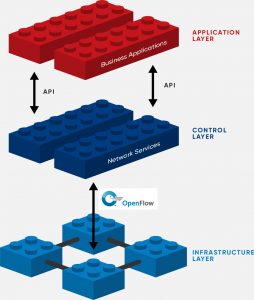Software-Defined Networking (SDN) is an emerging architecture that is dynamic, manageable, cost-effective, and adaptable, making it ideal for the high-bandwidth, dynamic nature of today’s applications. This architecture decouples the network control and forwarding functions enabling the network control to become directly programmable and the underlying infrastructure to be abstracted for applications and network services. The OpenFlow® protocol is a foundational element for building SDN solutions.
The SDN Architecture is:
DIRECTLY PROGRAMMABLE
Network control is directly programmable because it is decoupled from forwarding functions.
AGILE
Abstracting control from forwarding lets administrators dynamically adjust network-wide traffic flow to meet changing needs.
CENTRALLY MANAGED
Network intelligence is (logically) centralized in software-based SDN controllers that maintain a global view of the network, which appears to applications and policy engines as a single, logical switch.
PROGRAMMATICALLY CONFIGURED
SDN lets network manages configure, manage, secure, and optimize network resources very quickly via dynamic, automated SDN programs, which they can write themselves because the programs do not depend on proprietary software.
OPEN STANDARDS-BASED AND VENDOR-NEUTRAL
When implemented through open standards, SDN simplifies network design and operation because instructions are provided by SDN controllers instead of multiple, vendor-specific devices and protocols.

